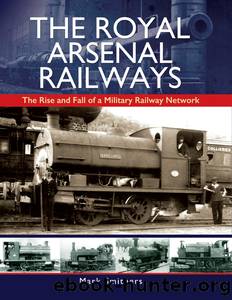The Royal Arsenal Railways by Smithers Mark;

Author:Smithers, Mark; [Smithers, Mark;]
Language: eng
Format: epub
Tags: TRANSPORTATION / Railroads / History
ISBN: 4448647
Publisher: Pen & Sword Books
Published: 2016-03-30T14:00:00+00:00
For reasons that have never been fully explained this 0-4-0WT was supplied by Fox, Walker & Co. to the War Department in 1878 as the Makersâ class WATE for use within the Arsenal. Constructed to the same design as Billy (rebuilt) and Dickie of Crewe Works fame, this locomotive (which could be driven from either end) had cylinders of only 5.5in x 6in, wheels 15in diameter and (probably) a working pressure of only 90psi. It would have been of little practical use for the Arsenalâs traffic requirements although, as suggested in the main text, its building date may have been of significance when one takes into account Lieutenant Colonel Beaumontâs experimental work of the period. The locomotive had certainly been disposed of by the Arsenal before 1898 and in all probability several years prior to this date. (Makerâs photograph)
Although the purchase of Iron Duke had demonstrated that the Arsenal authorities were prepared to seek enlarged locomotives from non-Leeds-based sources, a Leeds-based supplier was resorted to for the next group of designs to be supplied for use at the Arsenal. Before discussing these locomotives in detail, it will be helpful to consider the implications of developments relating to the Manning Wardle 6 x 8 0-4-0STs not constructed for use at Woolwich. In all, there were fifteen such locomotives: six of 18in gauge for use at Chatham Dockyard between 1871 and 1899; the similar example of the same gauge for the School of Military Engineering in 1873 already referred to, all of these having rectangular mainframes; three further 18in-gauge locomotives for Argentina between 1890 and 1924 having chamfered mainframes, with an earlier locomotive of the same gauge for Russia in 1875 believed also to possess the same; a 20in-gauge specimen of the same vintage for a Scottish colliery with only slightly chamfered mainframes; a 2ft-gauge 1874-built example again for colliery usage with pronounced chamfered mainframes; and two further 2ft-gauge examples of 1874 and 1877 about which little is known, save for the fact that the earlier example later turned up as a âcontractorâs locomotiveâ on the Darjeeling Himalayan Railway. The importance of this analysis is that a dichotomy opened up at an early stage in the evolution of the Manning Wardle âslim gaugeâ 0-4-0ST locomotives that was to manifest itself not only at the Royal Arsenal, but also in the sphere of the well-known and largely still extant Quarry Hunslet group of classes built for use in North Wales. The choice of whether to adopt the simplicity and robustness of simple rectangular mainframes or use a configuration chamfered at its leading and/or trailing lower edges was normally determined by considerations of ease of access to areas between the frames, the length of overhang (particularly at the rear end) and the abundance of gradients on the locomotiveâs working route. Be that as it may, the next two narrow-gauge locomotives to be delivered to the Arsenal adopted the simple rectangular mainframe configuration, rather in the manner of Manning Wardle Works No. 424 Busy Bee delivered to Chatham Dockyard over a decade earlier.
Download
This site does not store any files on its server. We only index and link to content provided by other sites. Please contact the content providers to delete copyright contents if any and email us, we'll remove relevant links or contents immediately.
| Automotive | Engineering |
| Transportation |
Whiskies Galore by Ian Buxton(41525)
Introduction to Aircraft Design (Cambridge Aerospace Series) by John P. Fielding(32885)
Small Unmanned Fixed-wing Aircraft Design by Andrew J. Keane Andras Sobester James P. Scanlan & András Sóbester & James P. Scanlan(32570)
Craft Beer for the Homebrewer by Michael Agnew(17930)
Turbulence by E. J. Noyes(7695)
The Complete Stick Figure Physics Tutorials by Allen Sarah(7135)
Kaplan MCAT General Chemistry Review by Kaplan(6591)
The Thirst by Nesbo Jo(6432)
Bad Blood by John Carreyrou(6271)
Modelling of Convective Heat and Mass Transfer in Rotating Flows by Igor V. Shevchuk(6219)
Learning SQL by Alan Beaulieu(6030)
Weapons of Math Destruction by Cathy O'Neil(5825)
Man-made Catastrophes and Risk Information Concealment by Dmitry Chernov & Didier Sornette(5644)
Digital Minimalism by Cal Newport;(5388)
Life 3.0: Being Human in the Age of Artificial Intelligence by Tegmark Max(5182)
iGen by Jean M. Twenge(5158)
Secrets of Antigravity Propulsion: Tesla, UFOs, and Classified Aerospace Technology by Ph.D. Paul A. Laviolette(4984)
Design of Trajectory Optimization Approach for Space Maneuver Vehicle Skip Entry Problems by Runqi Chai & Al Savvaris & Antonios Tsourdos & Senchun Chai(4837)
Electronic Devices & Circuits by Jacob Millman & Christos C. Halkias(4743)
